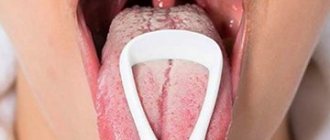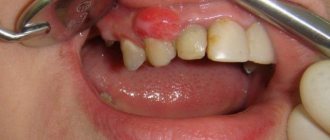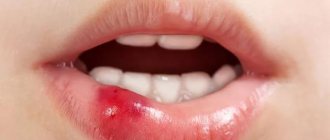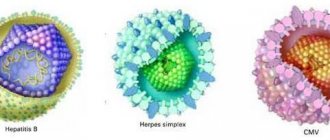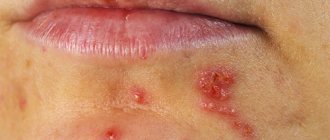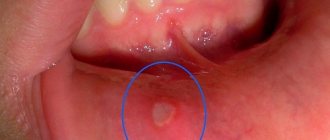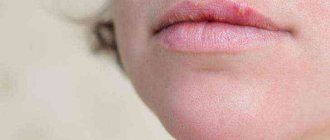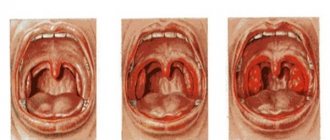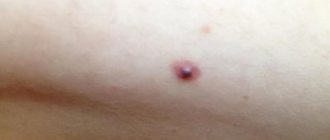Symptoms of herpes inside the lip
Note! Herpes simplex on the inner surfaces of the lips is characterized by the following symptoms:
- the formation of small bubbles, which can form groups of 5-10 pieces or more and are filled from the inside with a clear liquid;
- burning;
- swelling of the affected lip;
- slight increase in body temperature;
- tingling sensation in areas where rashes are localized;
- in rare cases, with severe disease - headache, joint pain, fever and chills.
Compared to the form of cold sores that appear on the outside of the lips, cold sores inside the lips can go away faster even without targeted treatment.
It is worth noting! Drug therapy is necessary at least to prevent the development of stomatitis against the background of lesions of the oral mucosa with herpes.
Stages of the disease
Many people notice herpes only when an ulcer appears. Unfortunately, at this stage the disease cannot be cured in one or two days, so it is best to detect its appearance earlier.
Internal herpes on the lip appears only during periods of weakened immunity.
Herpes inside the lips goes through several stages:
- The appearance of harbingers. Their role is played by itching and increased skin temperature in a small area of the lip. By paying attention to these symptoms, you can prevent the further development of herpes.
- Bubbles appear and gradually increase in size. Purulent contents accumulate inside, which creates pressure and causes pain both when touching the rash and in a calm state. This period lasts several days.
- The bubbles burst. The fluid released inside comes out, and relief occurs. The wounds are painful when eating and moving the lip, but when talking, the pain disappears.
- The ulcer is healing. A purulent loose crust forms on its surface. You cannot tear it off, as this can cause bleeding, infection of the wound and the formation of a scar.
- The crust falls off, and after a few days the wound heals.
Causes of the disease
The HSV-1 virus, once entered into the body, remains in it forever in a latent and conditionally harmful form.
Over the course of a lifetime, this disease may not manifest itself in any way, or, on the contrary, it may worsen regularly. It depends on the immunity of the specific carrier.
In turn, the activity of the immune system can be disrupted under the influence of such negative factors:
- excessive fatigue;
- hormonal imbalances;
- exacerbation of any infectious chronic diseases;
- suffered stress;
- avitaminosis;
- general hypothermia of the body.
Stay up to date! Often the herpes virus is activated on the inner surfaces of the lips when the mucous membrane is injured. For example, this can be observed when accidentally biting your lip.
Characteristics of herpes simplex virus (type 1 and 2)
The disease is characterized by:
- Dangerous to the human nervous system. Herpes on the corners of the lips with complications can cause pathologies of the nervous system.
- Suppression of immunity.
- Neurotropism - the ability of an infectious agent to penetrate a healthy cell, infecting it.
The virus is able to inhibit phagocytosis: a process in which special blood cells capture infectious pathogens, destroying them. This aggressive behavior of the herpes virus makes it possible for people to carry it latently for many years. Only in the presence of associated negative factors can the disease manifest itself; this happens even in adulthood.
Thus, the type of virus in question is characterized by two phases of its presence in the human body:
- Manifestation. This phase occurs several times throughout the year. The clinical picture of the disease is visually visible on the lips. It usually lasts 5-8 days. Most often, herpes occurs repeatedly in the corner of the mouth, 2-3 times a year in people with weakened immune systems.
- The latent phase - it lasts the entire period the virus remains in the body; the human immune system does not recognize it.
Stages of development
Herpes inside the lip develops in several stages.
For your information! The “zero” stage can be considered the incubation period, which, depending on the age and state of the patient’s immunity, can range from three days to two weeks.
Further, herpes develops as follows :
- Stage I. The average duration is up to two days, during which foci of inflammatory processes in the mouth only form and appear as redness with a diameter of no more than 5 millimeters. When you touch such areas, you may feel tingling, irritation, or pain.
- Stage II . Inflammation intensifies , pain becomes more pronounced, and redness begins to degenerate into dense swelling .
- Stage III . Swellings develop into blisters , and if they are too close to each other, they can merge into a single formation. Pus and lymph accumulate inside the blisters , and in this fluid the concentration of the herpes virus is too high to pierce or open these formations on your own. This can lead to infection of the oral mucosa.
- Stage IV . The bubbles burst , their contents come out, and ulcers or erosions form . This stage is the most dangerous in terms of transmitting the virus to others. Therefore, during this period, which can last up to three days, it is necessary to carefully monitor compliance with hygiene rules and avoid close bodily contact with other people. This is especially true for kissing. At this time, the patient himself feels the most severe pain during the entire period of the disease. In the most severe cases, a short-term deterioration in general health is possible in the form of enlarged lymph nodes and pain in them, as well as swelling of the neck, lower face and lips.
At the fifth stage, healing of the ulcers occurs .
Keep in mind! This process lasts up to two weeks, during which the mucous membranes regenerate and erosions finally disappear.
Treatment
Treatment of herpes on the inside of the lip is longer and more complex than the treatment of herpes on the outside.
This is due to damage to the mucous membrane, on which dry crusts do not form during healing.
Moreover, external ointments also do not remain on this surface for a long time (they are washed off with saliva).
Therefore, in most cases, such drugs must be combined with antiherpetic tablets.
They are absorbed into the blood and act from the inside, and the dosage of active components in them is higher than in ointments and gels.
Know! During such therapy, it is advisable for patients to avoid spicy, salty and fatty foods, as well as alcoholic, carbonated, excessively hot and cold drinks.
Smoking should also be limited during this period.
At the same time, you need to include fresh fruits and vegetables in your diet . They help strengthen the immune system, resulting in faster treatment.
Drug therapy
To treat herpes inside the lip, it is better to use the least toxic drugs that will not have an additional irritating effect on the mucous membrane.
Such means are:
- acyclovir;
- medovir;
- valacyclovir;
- herpevir;
- Zovirax;
- virolex.
Need to know! These drugs are available in both topical ointments and tablet form, and the optimal treatment option is a combination of these two forms.
But among these preparations there may be gels that are less preferable for application to internal surfaces.
Due to their thinner consistency, they are quickly washed off from the affected surface with saliva.
Ointments are more viscous, so they last longer.
After applying the drug, you should try not to swallow saliva and refrain from eating for the next half hour.
After this time, your mouth should be rinsed well .
Folk remedies
Note! Additionally, you can use unconventional methods of getting rid of herpes.
The application of many folk remedies to the mucous membranes can cause burning and additional irritation.
Therefore, it is better to use “soft” means , including:
- Fir oil. The product is applied every two hours to the affected areas with a cotton swab.
- Earwax. It should be applied in small quantities once a day for 15 minutes.
- Aloe juice. This product must first be diluted with boiled or purified bottled water in a ratio of 1:10 to 1:5. Depending on sensitivity to juice, the concentration can be selected individually. The product can be used up to 4-5 times a day at any stage of herpes development to eliminate swelling, pain and inflammation.
- Calendula juice and Vaseline . These components are mixed in a ratio of 2 to 1. The resulting composition is rubbed once a day into the localization of herpes blisters.
Traditional methods
Traditional medicine knows a number of remedies based on plant juices and oils that relieve inflammation and pain from herpes. For example:
- aloe juice;
- tea tree oil;
- calendula oil;
- eucalyptus oil.
A small amount of juice or oil is applied to the tampon. They carefully moisten the surface of the ulcer. You should be prepared for the possibility of itching or burning. Allergies cannot be ruled out: many herbal preparations are allergenic.
You can use a weak salt solution - 1-2 teaspoons per glass of water. You need to rinse your mouth with this solution several times a day. For the same purposes, decoctions of St. John's wort, lemon balm or chamomile are used. A decoction of oak bark, tincture of sage or calendula is also recommended.
When using folk remedies, in any case combine it with antiviral drugs, since none of the herbal medicines can fight the virus. After defeating herpes, take care to increase your immunity, eat more fruits and be outdoors more often.
5 / 5 ( 2 voices)
Possible complications
The herpes virus easily spreads to the mucous membranes, and in the oral cavity at the third stage of development of lip lesions, the spread of herpes with the subsequent development of stomatitis is possible.
Important! In turn, this disease can lead to complications in the kidneys and heart, as well as affect the nervous system.
Such severe consequences are mainly typical for young children.
If purulent-lymphatic accumulations penetrate not only into the oral cavity, but also further into the larynx, the development of herpetic sore throat is possible.
This disease, if not treated in a timely manner, can also cause complications in the nervous and cardiovascular systems.
Features of labial herpes in a child
The cause of herpetic infection on the lips in childhood is partially influenced by the age of the child. If infants and 1-year-old children have a risk of infection when kissing a carrier of the virus (often this is the mother), then at 2 years old children have a larger social circle. There is no limit to the activity of a child at 3, 4, 5 years old - he needs to know everything and be everywhere, so they are faced with an even larger number of virus carriers.
The development and spread of herpes on the lips in childhood is influenced by ignorance of hygiene rules and unconscious actions. A child can scratch the rash with his hand, thereby spreading the infection to healthy areas. Herpetic rashes spread to the cheeks, nose, chin and affect the mucous membranes of the mouth. Because of this kind of precedent, the disease lasts longer and often takes on complicated forms.
You can see what herpes looks like on a child’s lips in the photo.
